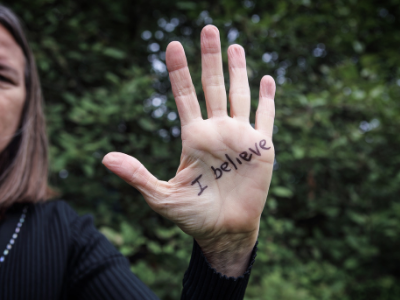Note: for the sake of this article, the terms “victim” and “survivor” will be used interchangeably, as individuals who experience sexual violence often feel a connection to one or both of these terms.
Sexual violence — defined as any sexual act committed against someone without that individual’s freely-given consent — is a critical social problem; one that social movements including #NotOkay, #MeToo, and #TimesUp have recently brought to the forefront of media discourse surrounding violence, gender, sex, safety, and health.
One need only look at the Vox.com list of 252 celebrities, politicians, CEOs, and high-profile individuals recently accused of sexual misconduct — including the President of the United States and newly-appointed Supreme Court Justice Brett Kavanaugh — to grasp the scope of this crisis [1].
 This problem has surfaced across social contexts, and survivors are coming forward in droves to share their stories, seek justice, hold perpetrators accountable, and lead the nation toward a safer, kinder, softer future. As our nation grapples with the acute catastrophe of sexual violence, it is critical that we look to data and research to illuminate our discussions surrounding sexual victimization, survivor justice, and the requisite gentleness of our national discourse.
This problem has surfaced across social contexts, and survivors are coming forward in droves to share their stories, seek justice, hold perpetrators accountable, and lead the nation toward a safer, kinder, softer future. As our nation grapples with the acute catastrophe of sexual violence, it is critical that we look to data and research to illuminate our discussions surrounding sexual victimization, survivor justice, and the requisite gentleness of our national discourse.
According to the Centers for Disease Control and Prevention, about 1 in 3 women and nearly 1 in 6 men are victims of contact sexual violence in their lifetime, with over 40 percent of women victims and about a quarter of men victims experiencing their first completed rape before the age of 18 [2].
Lesbian, gay, bisexual, transgender, non-binary, genderqueer, and genderfluid youth are at even higher risk for experiencing sexual violence; 46 percent of bisexual women and 47 percent of transgender people are sexually assaulted at some point in their lifetime, and trans women of color are widely regarded as being at the highest risk for experiencing sexual violence [3,4].
The intersections of marginalization clearly have a dramatic impact on the likelihood that individuals will experience sexual violence. Therefore, we must consider intersectionality when discussing sexual violence.
Although the narrative of sexual victimization tends to focus on the stereotype of the cisgender, straight, white, woman victim, victims with multiple marginalizations (or multiple experiences of social oppression) require increased care, attention, and efforts specifically designed to enhance their safety.
Health Outcomes of Sexual Violence
Importantly, survivors often experience a range of negative physical, sexual, and psychological health outcomes, including (but not limited to) [5-7]:
- Post-traumatic stress disorder
- Depression
- Anxiety
- Disordered eating and body dysmorphia
- Self-blame
- Non-suicidal self-injury
- Suicidality
- Social issues (especially social isolation and anxiety)
- Sexual dysfunction and dissociation
- Chronic illness
The list of potential health consequences of sexual victimization goes on, though it is important to note that each survivor may respond to their victimization experience differently, depending on their own experience, social network support, resiliency, coping strategies, and access to resources.
Notably, individuals who experience sexual violence once are vulnerable to revictimization. Further, stigmatization — or the process of managing labels, stereotypes, isolation (us vs. them mentalities), loss of social status, and discrimination — greatly impacts sexual violence survivors, and may decrease survivors’ confidence in sharing their experiences.
Incredibly, in spite of myriad potential negative health outcomes, as well as the stigma frequently faced by survivors of sexual violence (we need look no further than the GOP’s treatment of Dr. Christine Blasey Ford to affirm that this stigma exists), most survivors nevertheless choose to share their experience. The process of sharing an experience of sexual violence is referred to as “disclosure.”
 Interestingly, it is more common for survivors to disclose to an “informal” support provider — like a family member or a close friend — rather than “formal” resources like a counselor, campus Title IX offices, or members of law enforcement. This trend may indicate survivors’ distrust of the legal system, frustration toward a culture that frequently fails to hold perpetrators accountable, fear of being blamed for the assault, fear of punishment, or fear that the survivor will be accused of falsely reporting.
Interestingly, it is more common for survivors to disclose to an “informal” support provider — like a family member or a close friend — rather than “formal” resources like a counselor, campus Title IX offices, or members of law enforcement. This trend may indicate survivors’ distrust of the legal system, frustration toward a culture that frequently fails to hold perpetrators accountable, fear of being blamed for the assault, fear of punishment, or fear that the survivor will be accused of falsely reporting.
Survivors who do choose to disclose tend to be more likely to formally report against their perpetrator, better-equipped to receive the necessary support to engage in their healing process, and more able to place blame on the perpetrator than survivors who keep their experience private. In order to increase the likelihood that survivors report, it is vital that we as a culture improve our responses to survivors who come forward, and understand the way that social reactions to survivor disclosures shape the survivors’ healing experience.
Barriers to Reporting
Despite relatively high rates of disclosure to friends and loved ones, survivors report numerous barriers to disclosure, especially barriers to formal reporting. Cited barriers from college students, survivors of childhood sexual abuse, and adult survivors include [8,9]:
- Shame, guilt, and embarrassment
- Fear of being called gay (particularly salient for men survivors)
- Fear of retaliation by the perpetrator
- Fear of rejection by their community
- Concerns about confidentiality
- Fear of being disbelieved or blamed
- Lack of knowledge regarding the legal definition of rape or sexual assault
- Not labeling the experience as rape or not wanting to define their experience as rape
- Self-blame; believing the assault was “their fault”
- Receiving an initial negative social reaction to disclosure and not disclosing further due to fear of another negative response
- Desiring privacy or not wanting people to know about their experience
- Financial dependence on the perpetrator
- Not wanting the perpetrator to be prosecuted (especially if the perpetrator is a friend or family member)
- Disbelief or lack of confidence in a successful prosecution
- Lack of awareness regarding the importance of receiving medical treatment
- Lack of knowledge regarding help and resources
- Lack of access to resources or few available services
- Distrust or dislike of police or the justice system (especially salient for survivors of color)
- Cultural or language barriers to obtaining help
Survivors are forced to overcome a wide range of obstacles in order to feel safe and comfortable seeking help, to receive support throughout their process, or to potentially formally report their experience.
Each of the aforementioned obstacles reduces survivors’ likelihood to report to formal resources like law enforcement. In fact, according to the Rape, Abuse, and Incest National Network (RAINN), only about 23 percent of rape cases are ever reported to the police, meaning that the list of above concerns or obstacles could dissuade 77 percent (or more!) of survivors from filing an official report against their perpetrator [10].
So, though most survivors do share their experience with a friend or loved one, most choose not to report through formal channels.
False Reporting (a Brief Review)
One of the largest, most influential obstacles survivors cite to reporting is their own fear of being disbelieved. Survivors frequently choose not to report because they anticipate being accused of lying or experiencing the pain of having their stories invalidated — a form of revictimization referred to in the field of clinical psychology as the “second rape” or the “second assault.”
Unfortunately, this is a valid fear — one that we saw illuminated in the aftermath of the Kavanaugh and Dr. Ford testimonies.
In the context of the Kavanaugh hearings, the internet was flooded with the myth that women frequently falsely report sexual violence. It was hypothesized by social media users and national news outlets that they do so in order to get revenge against their alleged perpetrators, to make money off of wealthy figureheads, to “ruin the reputations” of powerful men, or to gain some form of prestige (though what prestige they are possibly seeking, I do not know). Even President Trump cast public doubt on Dr. Ford’s testimony, inquiring via Twitter why she hadn’t reported immediately after the event (for a list of potential obstacles to her reporting, see above).
Research across the fields of psychology, public health, criminology, and sexual and gender-based violence prevention asserts that instances of false reporting are very rare.
Unfortunately, the myth that individuals frequently falsely report has real, concrete consequences for victims of sexual violence. Research indicates that between 2 and 10 percent of formal reports (reports made to police) may be considered false, while the most reliable review statistic indicates a rate of false reports between 5 and 6 percent [11].
 However, literature on false reporting is limited, as definitions of what constitutes a “false report” vary across police precincts. The range of 2 to 10 percent may include reports that aren’t made by the victim themselves, but made by someone other than the victim, such as a relative or partner, on behalf of a victim who may not even be aware of the report.
However, literature on false reporting is limited, as definitions of what constitutes a “false report” vary across police precincts. The range of 2 to 10 percent may include reports that aren’t made by the victim themselves, but made by someone other than the victim, such as a relative or partner, on behalf of a victim who may not even be aware of the report.
Additionally, the range may include a combination of intentional misreports and reports that are “baseless” (the attack doesn’t meet the legal criteria of rape in that precinct, but the victim was not intentionally lying or misleading police). Some research indicates that these percentages may include cases in which the police chose to drop a case because they suspected the victim was lying, though they could not definitively prove that they victim was lying.
Similarly, literature suggests that police sometimes classify reports as false when they are skeptical about victims who are mentally ill, gave inconsistent statements, or had been drinking or using drugs, though police were not able to prove that the victims were lying. This points to a problematic trend of disbelief among law enforcement of victims with mental illness or substance abuse problems — two populations at heightened risk for experiencing assault.
Importantly, given research regarding trauma’s impact on the brain, memory, processing, and narrative formation, it is logical that survivors of sexual violence might give conflicting reports as they work to remember, piece together, and communicate their violence experiences.
Survivors and researchers have also reported a trend of police precincts threatening victims with a polygraph test to “prove” their story (a practice that is considered retraumatizing and could intimidate a victim out of reporting), or threatening victims with legal consequences if their report is false, which can frighten actual victims out of moving forward with the reporting process.
Interestingly, literature on actual false reports indicates that false reports commonly follow the stereotypical rape script: the “stranger in an alley” example wherein the perpetrator is unknown to the victim, the perpetrator uses a weapon, the victim struggles, the victim has bruises or signs of injury, the victim is sober, the victim is visibly upset, the victim reports immediately, there is forensic evidence of assault, etc.
Indeed, if an individual were to choose to lie about a crime, it would make sense that they would want their report to look like the perfect example of that crime, in order to enhance believability. However, this does not mean we should begin to doubt reports that follow the stereotypical rape script.
 Rather, it indicates that reports featuring more complex characteristics (the victim was intoxicated, the victim froze or didn’t fight back, the victim had a sexual history with the perpetrator, the perpetrator was a friend or acquaintance, the victim reported inconsistent memories or an inconsistent story, the perpetrator did not use a weapon or make verbal threats) should be taken equally seriously by law enforcement.
Rather, it indicates that reports featuring more complex characteristics (the victim was intoxicated, the victim froze or didn’t fight back, the victim had a sexual history with the perpetrator, the perpetrator was a friend or acquaintance, the victim reported inconsistent memories or an inconsistent story, the perpetrator did not use a weapon or make verbal threats) should be taken equally seriously by law enforcement.
In order to address the crisis of sexual violence, to hold perpetrators accountable, and to increase survivors’ likelihood to formally report their experiences, it is vital that survivors are not investigated or interrogated, but that law enforcement agents pursue what is called trauma-informed questioning.
Moreover, it is important to note the potential benefits of expressing belief and support of victims — especially that victims themselves may experience less negative health outcomes and may be more likely to file a report against their perpetrator, which keeps their communities safer by proxy.
Survivors who receive responses of belief are less likely to experience self-blame, more likely to label their experience an assault, and more likely to place appropriate blame on the perpetrator. It is worth noting that many sexual assaults are committed by serial perpetrators (that is, perpetrators who will violate multiple victims). So, empowering survivors to bring perpetrators to justice through trauma-informed law enforcement practices may reduce population-level victimization by limiting the opportunities of serial perpetrators to continue causing harm.
A Note to Survivors, From the Author
And now, my wonderful and brave and miraculous loves, I get to turn my focus to you — the people who most deserve these words, this support, and any comfort I can possibly offer.
First, I would like to say what an honor it is to share community with you. As a survivor myself, I know that we frequently carry the burden of advocating for ourselves and our community. I hope that this piece has in some way reduced this burden on you, or helped you to feel seen and heard. It is my privilege to take part in this discussion, and my privilege to draw public attention to our needs. A few words of validation:
 You do not owe your stories to anyone. You do not owe the world your narrative, or your pain. Be soft with yourself. Your experience was hard enough – you get to heal in whatever way works best for you. I acknowledge that much of the news coverage of movements like #MeToo have celebrated the survivors coming forward, and that doing so might be harmful to survivors who choose to keep their stories private. Know that this decision is yours, only. Living with your experience is brave.
You do not owe your stories to anyone. You do not owe the world your narrative, or your pain. Be soft with yourself. Your experience was hard enough – you get to heal in whatever way works best for you. I acknowledge that much of the news coverage of movements like #MeToo have celebrated the survivors coming forward, and that doing so might be harmful to survivors who choose to keep their stories private. Know that this decision is yours, only. Living with your experience is brave.
You don’t need to report it if you are not ready, if that will not be a healing experience for you, or if you choose not to. Your narrative is your own, period.
No one should have to go through the process of reporting without the help of an advocate specifically trained go offer you the necessary support. If you are interested in reporting and would like to access an advocate, check the Resources section below.
You are loved. You are worthy. You are valuable.
I believe you.
I support you.
I am here for you.
You matter.
Regardless of whether you ever choose to share your story – your experience matters.
You deserve kindness, respect, and to be treated with dignity.
You did nothing wrong.
You are not to blame.
Resources
- If you are interested in reporting and would like to access an advocate, the Rape, Abuse, and Incest National Network (RAINN) hotline can direct you to these resources, either online or by phone (1-800-656-4673).
- For self-care resources on coping with trauma, click here.
- To learn more about trauma-informed victim interviewing, click here.
Read Also
Want to support women? Check out this FREE Course.
Women are being sexually harassed and assaulted in and out of the gym — and we need your help!
Interested in helping? If so, we’ve created a FREE course just for you!
→ Get access now, and start whenever you’re ready:

References
- https://www.vox.com/a/sexual-harassment-assault-allegations-list
- https://www.cdc.gov/violenceprevention/pdf/NISVS-StateReportFactsheet.pdf
- https://www.hrc.org/resources/sexual-assault-and-the-lgbt-community
- https://www.transequality.org/sites/default/files/docs/USTS-Full-Report-FINAL.PDF
- http://citeseerx.ist.psu.edu/viewdoc/download?doi=10.1.1.620.1866&rep=rep1&type=pdf
- https://www.ncbi.nlm.nih.gov/pmc/articles/PMC4043331/
- https://www.researchgate.net/profile/Emily_Dworkin/publication/24418930_An_Ecological_Model_of_the_Impact_of_Sexual_Assault_On_Women’s_Mental_Health/links/572f9de308ae744151904b7e.pdf
- http://www.middlebury.edu/media/view/240971/original/sable_article.pdf
- https://www.rainn.org/statistics/criminal-justice-system
- https://files.eric.ed.gov/fulltext/ED449712.pdf
- https://www.ncbi.nlm.nih.gov/pubmed/21164210
